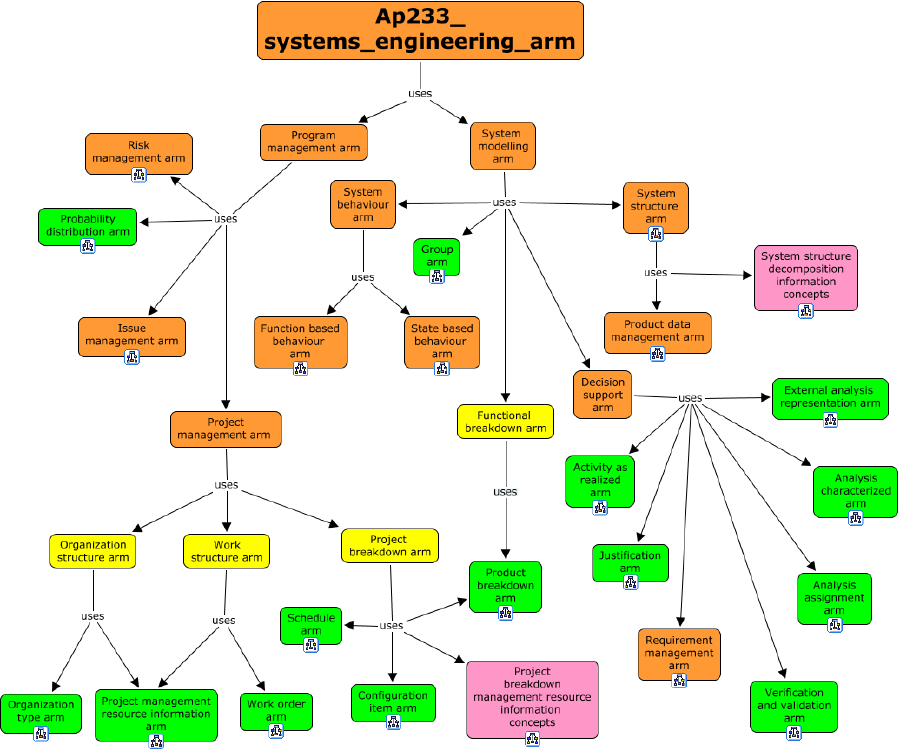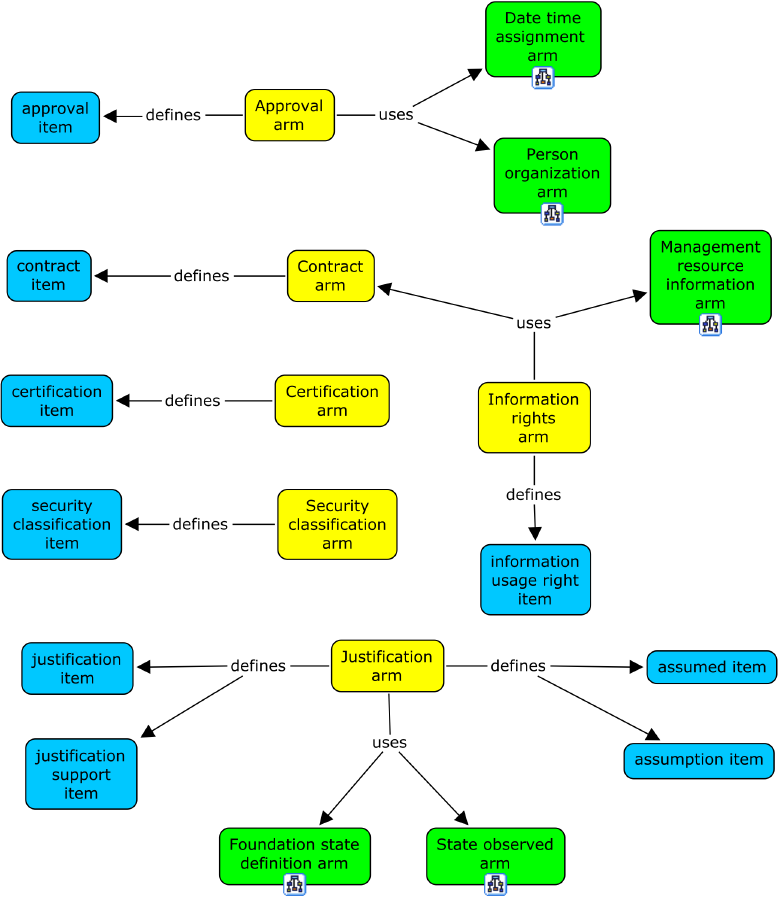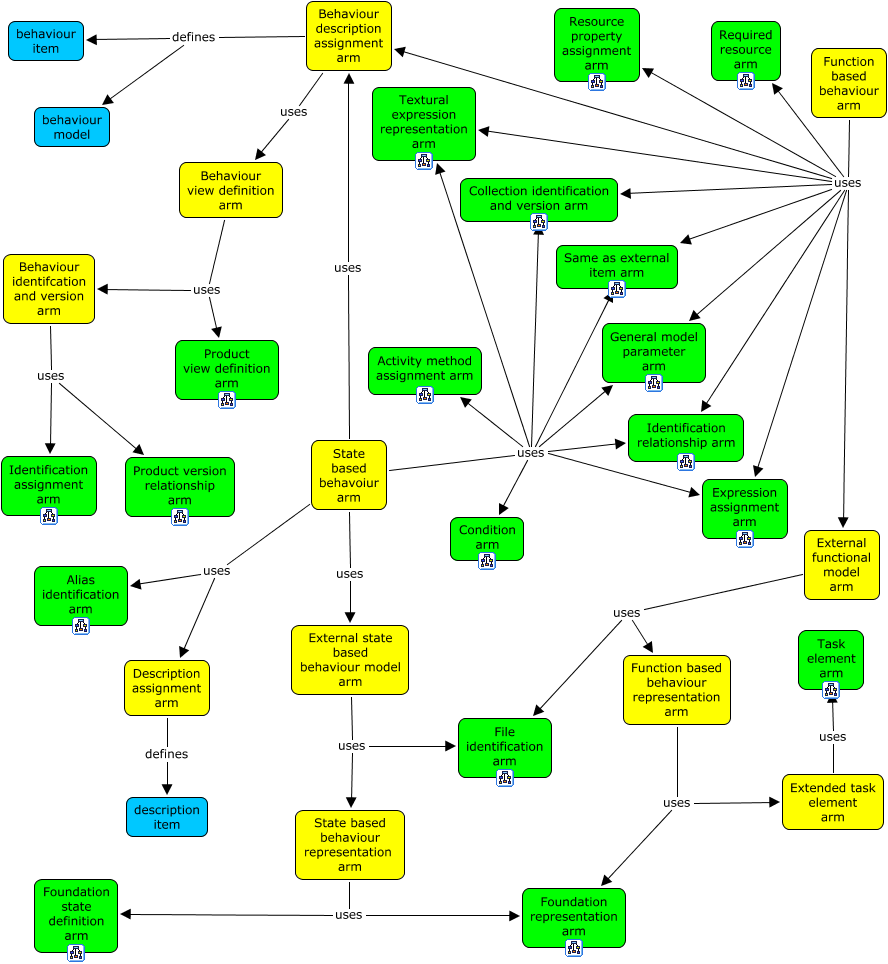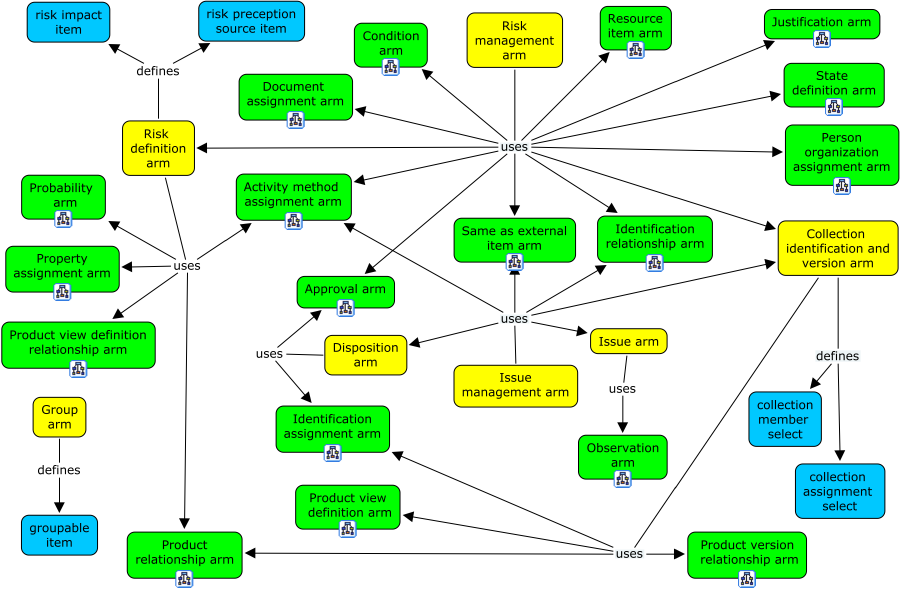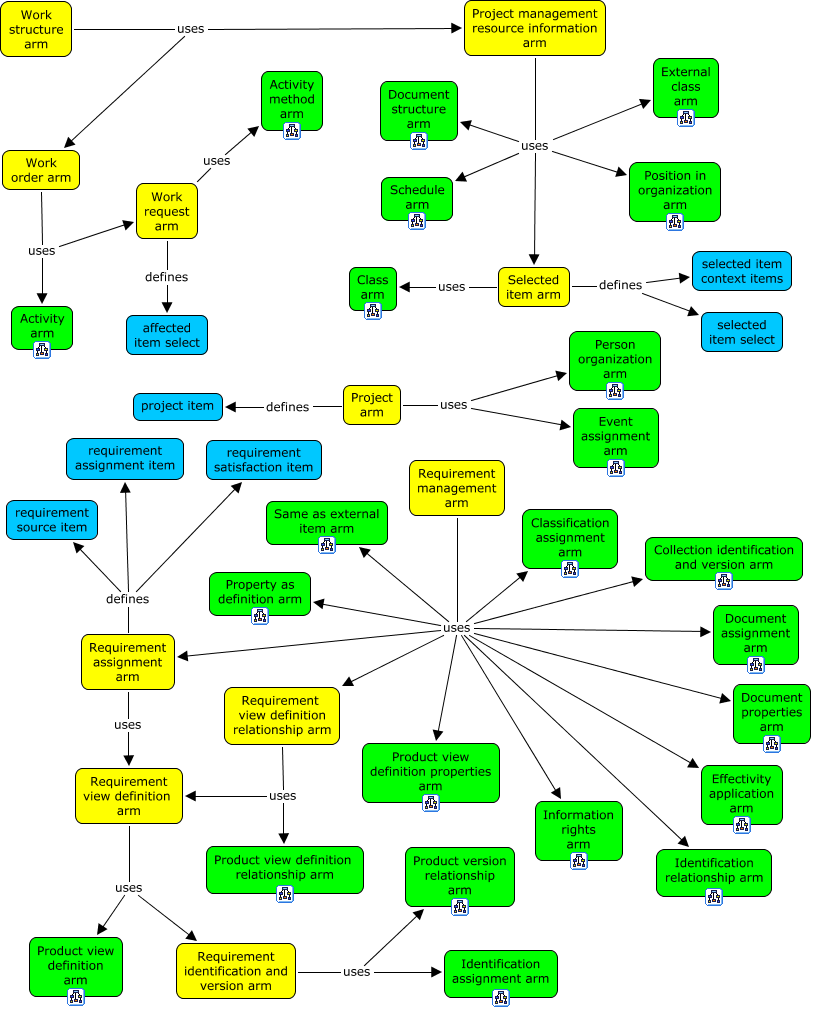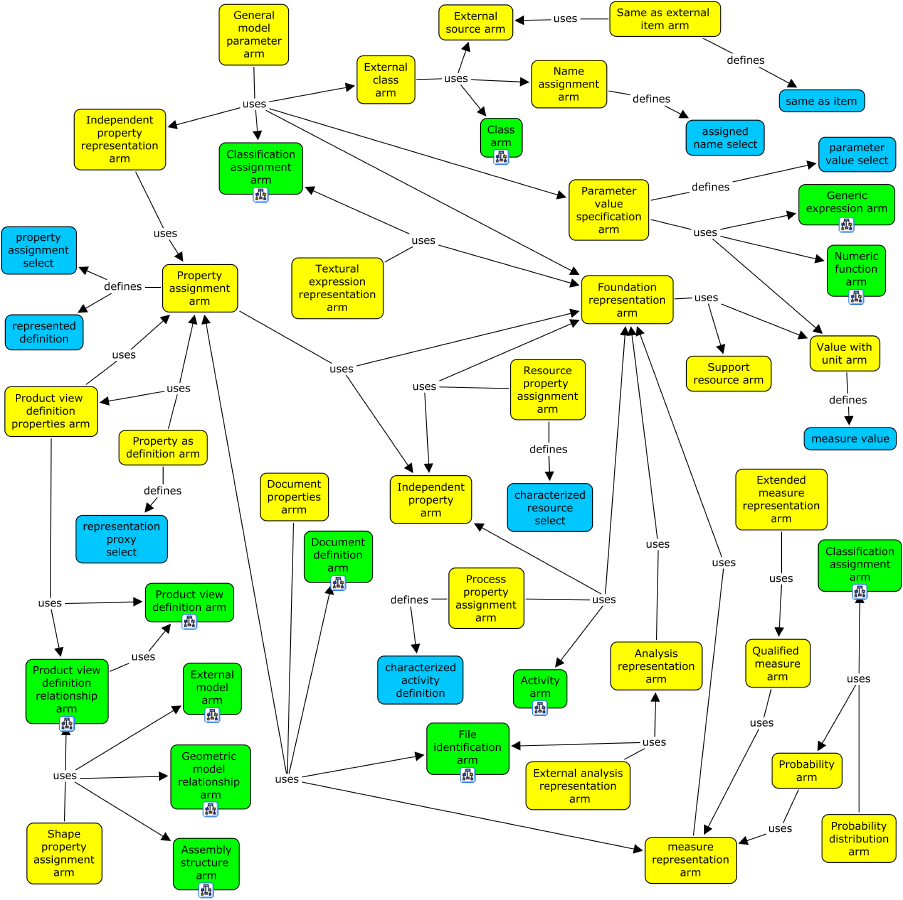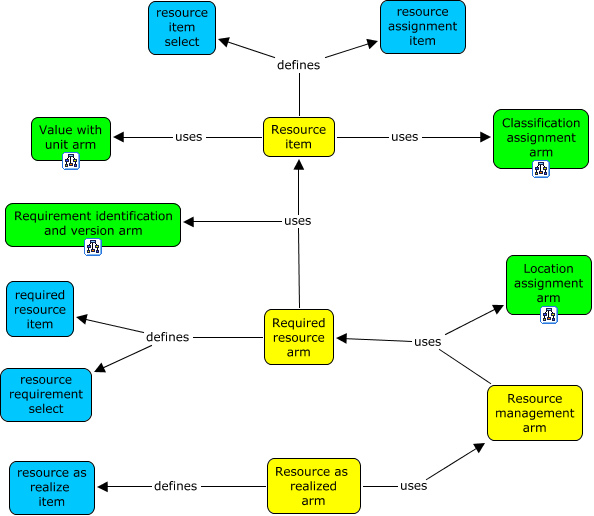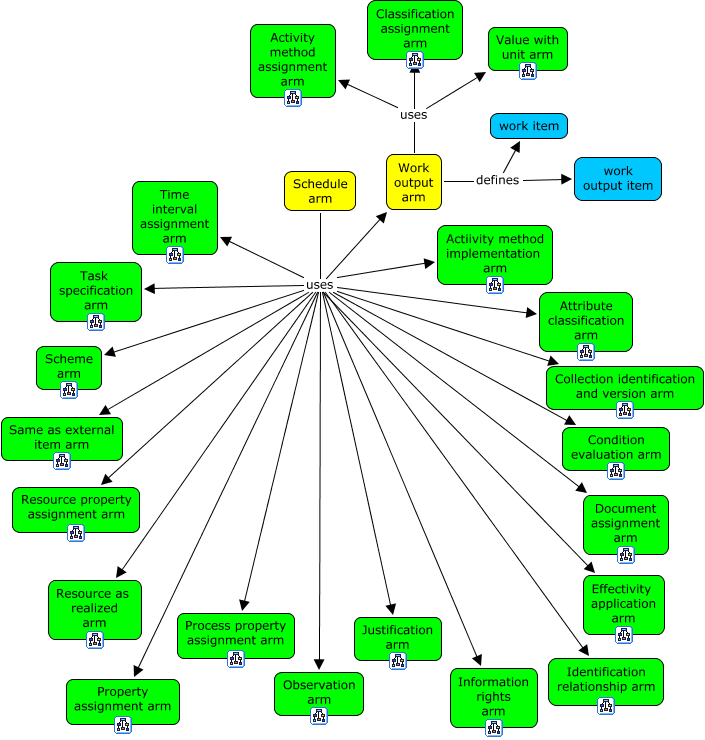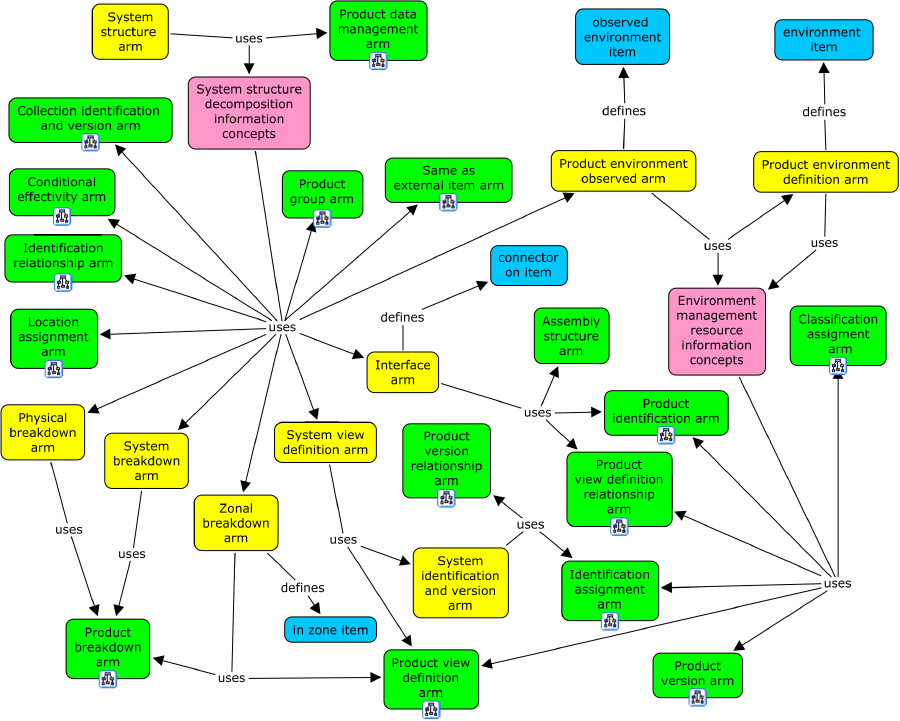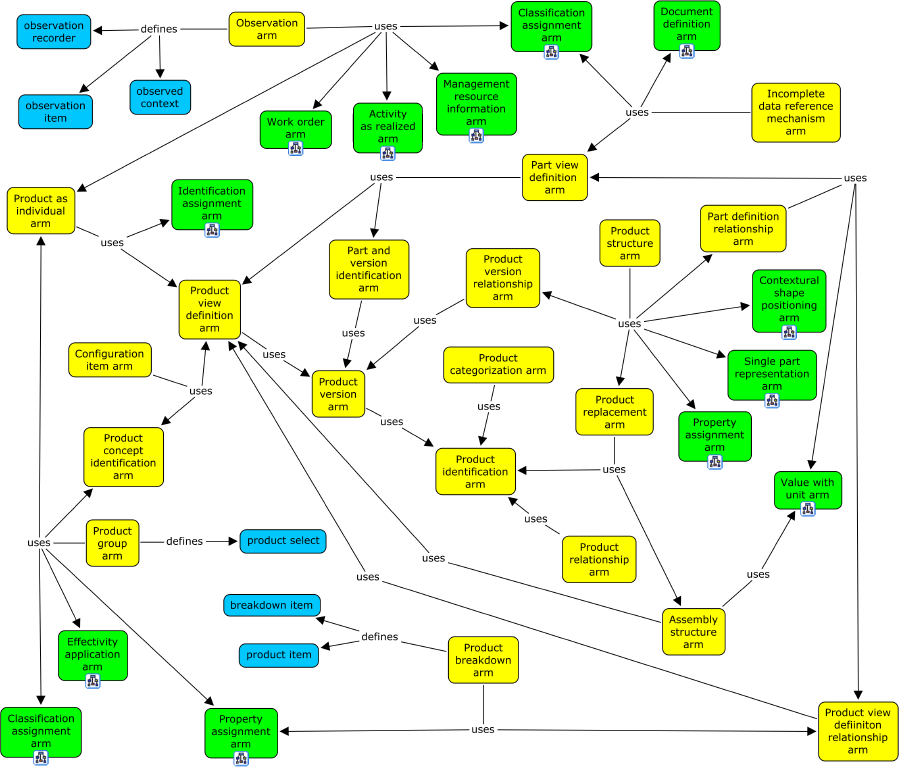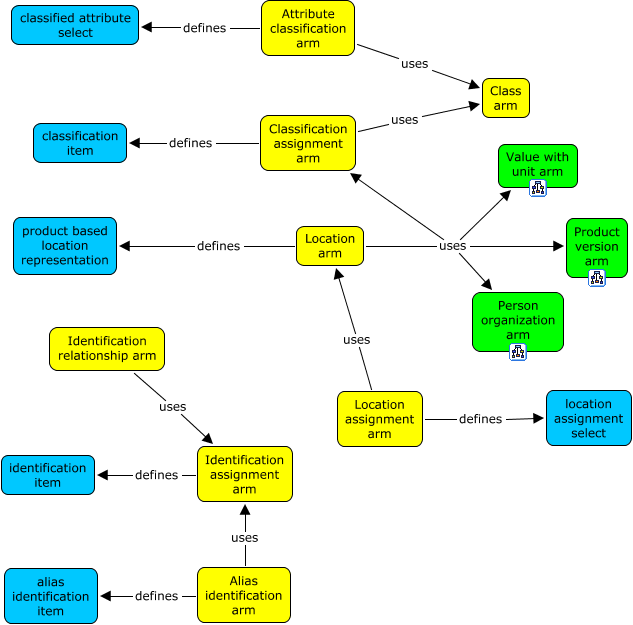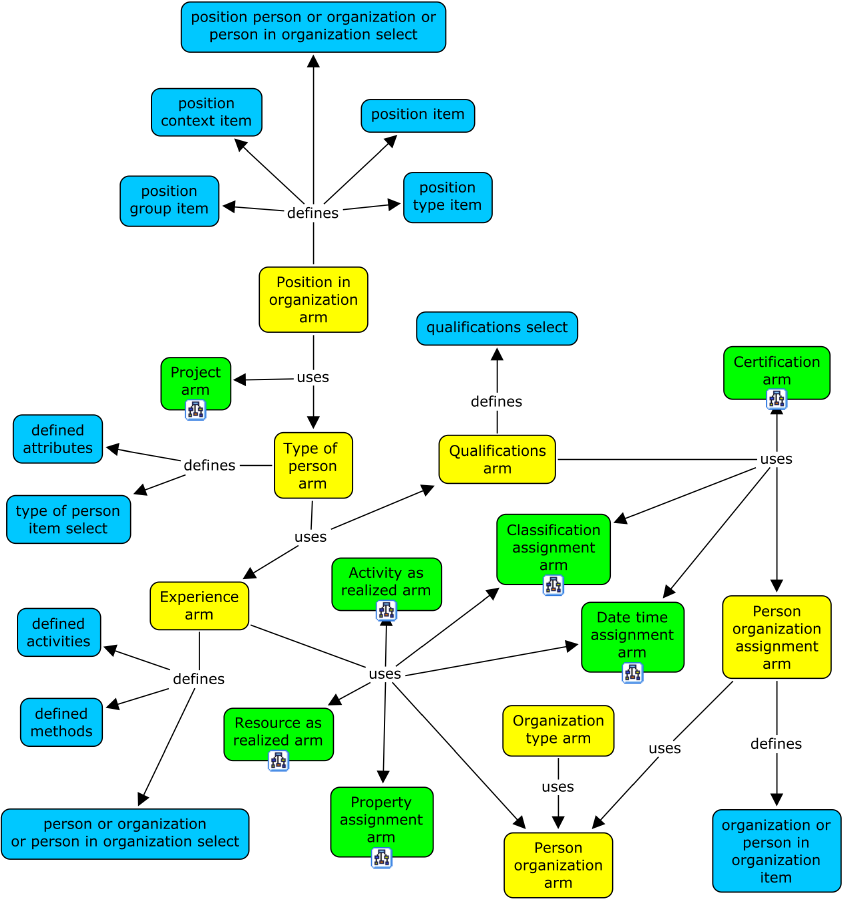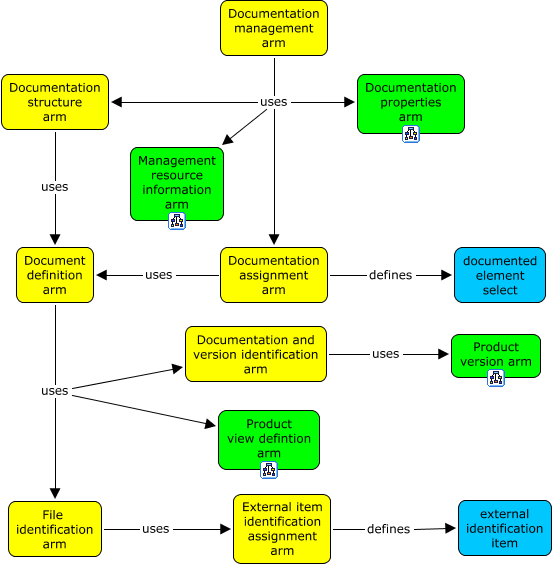|
|
Application module:
AP233 systems engineering |
ISO/TS 10303-433:2011-10(E)
© ISO
|
Annex F
(informative)
Application module implementation and usage guide
F.1 Concept maps
The following series of concept maps show module USE FROM connectivity and where Extensible select types
are defined. The color coding is provided in Figure
F.1.
Figure F.1 — Color coding of concept map boxes
F.2 Systems engineering concepts
The top level hierarchy of modules used to enable systems engineering concepts is shown
in Figure F.2.
Below this level of abstraction modules are extensively networked together. To see into this modules networking
quagmire, modules have been grouped together relative to a few high level loosely defined natural language concepts.
The grouping simply provides a visualization aid that the AP233 development team has found useful.
Figure F.2 — Systems engineering concepts
Capabilites that enable systems engineering concepts are realized by:
Additionally these modules USE FROM several foundational modules that enable common ISO 10303 project concepts:
- items within the scope of application module Activity as realized - continued in Activity concepts figure
F.3;
- items within the scope of application module Analysis assignment - continued in the How concepts figure
F.6;
- items within the scope of application module Analysis characterized - continued in the How concepts figure
F.6;
- items within the scope of application module Configuration item - continued in the System concepts figure
F.13;
- items within the scope of application module External analysis representation - continued in the Activity concepts figure
F.3;
- items within the scope of application module Function based behaviour - continued in the Behaviour concepts figure
F.5;
- items within the scope of application module Group - continued in the Issue-Risk-Group concepts figure
F.7;
- items within the scope of application module Justification - continued in the Authorization concepts figure
F.4;
- items within the scope of application module Organization type - continued in the Who concepts figure
F.18;
- items within the scope of application module Probability distribution - continued in the Representation concepts figure
F.10;
- items within the scope of application module Product data management - continued in the Management resource information figure
F.8;
- Project breakdown management resource information concepts - continued in the Management resource information figure
F.8;
- items within the scope of application module Project management resource information - continued in the Management resource information figure
F.8;
- items within the scope of application module Requirement management - continued in the Project concepts figure
F.9;
- items within the scope of application module Risk management - continued in the Issue-Risk-Group concepts figure
F.7;
- items within the scope of application module Schedule - continued in the Schedule concepts figure
F.12;
- items within the scope of application module State based behaviour - continued in the Behaviour concepts figure
F.5;
- items within the scope of application module System breakdown - continued in the System concepts figure
F.13;
- items within the scope of application module System structure - continued in the System concepts figure
F.13;
- System structure decomposition information concepts - continued in the System concepts figure
F.13;
- items within the scope of application module System view definition - continued in the System concepts figure
F.13;
- items within the scope of application module Verification and validation - continued in the How concepts figure
F.6;
- items within the scope of application module Work order - continued in the Project concepts figure
F.9.
F.3 Activity concepts
The modules and extensible select information items that are networked together to
model activity concepts in AP233 are shown in Figure
F.3.
Figure F.3 — Activity concepts
Capabilites that enable activity concepts are realized by:
Additionally these modules USE FROM several foundational modules that enable common ISO 10303 project concepts:
Extensible select types provide the cross coupling of concepts needed to realize the whole:
- activity_item is an item that can be assigned an activity;
- activity_method_item a product or activity data item to which an applied activity method can be assigned;
- activity_realization_select a product or activity data item that can realize an activity method;
- constraint_context a task element within which a constraint applies;
- scheme_entry_item_select a product or activity data item which can be associated with a scheme entry;
- scheme_subject_select a product or activity data item which can be associated with a scheme;
- scheme_version_select a product or activity data item which can be associated with a scheme version;
- state_definition_of_item an object whose mode of being (i.e. state) can be described and known by a state definition;
- state_of_item an activity or product data item which can have a state or be a state;
- task_item a product or activity item that can be associated with the representation of all or part of how to undertake a task.
F.4 Authorization concepts
The modules and extensible select information items that are networked together to
model authorization concepts in AP233 are shown in Figure
F.4.
Figure F.4 — Authorization concepts
Capabilites that enable authorization concepts are realized by:
Additionally these modules USE FROM several foundational modules that enable common ISO 10303 project concepts:
Extensible select types provide the cross coupling of concepts needed to realize the whole:
F.5 Behaviour concepts
The modules and extensible select information items that are networked together to
model behaviour concepts in AP233 are shown in Figure
F.5.
Figure F.5 — Behaviour concepts
Capabilites that enable behaviour concepts are realized by:
Additionally these modules USE FROM several foundational modules that enable common ISO 10303 project concepts:
Extensible select types provide the cross coupling of concepts needed to realize the whole:
- behaviour_item the behaviour item whose behaviour is represented by the behaviour model;
- behaviour_model the behaviour model which is used to represent the behaviour of the a product or activity data item;
- description_item an item to which a description may be assigned.
F.6 How concepts
The modules and extensible select information items that are networked together to
model how concepts in AP233 are shown in Figure
F.6.
Figure F.6 — How concepts
Capabilites that enable how concepts are realized by:
Additionally these modules USE FROM several foundational modules that enable common ISO 10303 project concepts:
Extensible select types provide the cross coupling of concepts needed to realize the whole:
F.7 Issue-risk-group concepts
The modules and extensible select information items that are networked together to
model issue, risk and group concepts in AP233 are shown in Figure
F.7.
Figure F.7 — Issue, risk and group concepts
Capabilites that enable issue, risk and group concepts are realized by:
Additionally these modules USE FROM several foundational modules that enable common ISO 10303 project concepts:
Extensible select types provide the cross coupling of concepts needed to realize the whole:
F.8 Management resource information concepts
The modules and extensible select information items that are networked together to
model management resource information concepts in AP233 are shown in Figure
F.8.
Figure F.8 — Management resource information concepts
Capabilites that enable management resource information concepts are realized by:
Additionally these modules USE FROM several foundational modules that enable common ISO 10303 project concepts:
F.9 Project concepts
The modules and extensible select information items that are networked together to
model project concepts in AP233 are shown in Figure
F.9.
Figure F.9 — Project concepts
Capabilites that enable project concepts are realized by:
Additionally these modules USE FROM several foundational modules that enable common ISO 10303 project concepts:
Extensible select types provide the cross coupling of concepts needed to realize the whole:
F.10 Representation concepts
The modules and extensible select information items that are networked together to
model representation concepts in AP233 are shown in Figure
F.10.
Figure F.10 — Representation concepts
Capabilites that enable representation concepts are realized by:
Additionally these modules USE FROM several foundational modules that enable common ISO 10303 project concepts:
Extensible select types provide the cross coupling of concepts needed to realize the whole:
F.11 Resource concepts
The modules and extensible select information items that are networked together to
model resource concepts in AP233 are shown in Figure
F.11.
Figure F.11 — Resource concepts
Capabilites that enable resource concepts are realized by:
Additionally these modules USE FROM several foundational modules that enable common ISO 10303 project concepts:
Extensible select types provide the cross coupling of concepts needed to realize the whole:
F.12 Schedule concepts
The modules and extensible select information items that are networked together to
model schedule concepts in AP233 are shown in Figure
F.12.
Figure F.12 — Schedule concepts
Capabilites that enable schedule concepts are realized by:
- items within the scope of application module Schedule;
- items within the scope of application module Work output.
Additionally these modules USE FROM several foundational modules that enable common ISO 10303 project concepts:
Extensible select types provide the cross coupling of concepts needed to realize the whole:
- work_item an item that can be a source that produces or delivers work output;
- work_output_item any product or activity data item that can be a representation of the item that is defined as work output (actual item or
type of item).
F.13 System concepts
The modules and extensible select information items that are networked together to
model system concepts in AP233 are shown in Figure
F.13.
Figure F.13 — System concepts
Capabilites that enable system concepts are realized by:
Additionally these modules USE FROM several foundational modules that enable common ISO 10303 project concepts:
Extensible select types provide the cross coupling of concepts needed to realize the whole:
F.14 What geometry concepts
The modules and extensible select information items that are networked together to
model what geometry concepts in AP233 are shown in Figure
F.14.
Figure F.14 — What geometry concepts
Capabilites that enable what geometry concepts are realized by:
Additionally these modules USE FROM several foundational modules that enable common ISO 10303 project concepts:
Extensible select types provide the cross coupling of concepts needed to realize the whole:
F.15 What concepts
The modules and extensible select information items that are networked together to
model what concepts in AP233 are shown in Figure
F.15.
Figure F.15 — What concepts
Capabilites that enable what concepts are realized by:
Additionally these modules USE FROM several foundational modules that enable common ISO 10303 project concepts:
Extensible select types provide the cross coupling of concepts needed to realize the whole:
- breakdown_item a product or activity data item that can be related to a View_definition_relationship or Product_view_definition in a product
breakdown;
- observation_recorder a product or a person data item capable of being identified as recording observational information (e.g. an identifiable
piece of equipment capable of being represented as a Product_as_realized);
- observation_item a data item capable of being the subject of an observation;
- observed_context a data item serving as the context in which an observation is made;
- product_item General: a product item that may be related to items in a breakdown via a product_definition_element_relationship. Specific:
a View_definition_relationship or Product_view_definition that is related to the Breakdown_element_definition or a Breakdown_element_usage;
- product_select a product or activity data item that can be idetentified as a member of a product group.
F.16 When concepts
The modules and extensible select information items that are networked together to
model when concepts in AP233 are shown in Figure
F.16.
Figure F.16 — When concepts
Capabilites that enable when concepts are realized by:
Additionally these modules USE FROM several foundational modules that enable common ISO 10303 project concepts:
Extensible select types provide the cross coupling of concepts needed to realize the whole:
- date_or_date_time_item an activity or product data item to which can be assigned a calendar date or a calendar data with time;
- effectivity_item an activity or product data item which has an effectivity (a domain of applicability) that can be characterized;
- event_item a product or activity data item to which an event can be assigned;
- time_interval_item an activity or product data item to which can be associated a time interval.
F.17 Where concepts
The modules and extensible select information items that are networked together to
model where concepts in AP233 are shown in Figure
F.17.
Figure F.17 — Where concepts
Capabilites that enable where concepts are realized by:
Additionally these modules USE FROM several foundational modules that enable common ISO 10303 project concepts:
- items within the scope of application module Person organization - continued in the Who concepts figure
F.18;
- items within the scope of application module Product version - continued in the What concepts figure
F.15;
- items within the scope of application module Value with unit - continued in the Representation concepts figure
F.10.
Extensible select types provide the cross coupling of concepts needed to realize the whole:
F.18 Who concepts
The modules and extensible select information items that are networked together to
model who concepts in AP233 are shown in Figure
F.18.
Figure F.18 — Who concepts
Capabilites that enable who concepts are realized by:
Additionally these modules USE FROM several foundational modules that enable common ISO 10303 project concepts:
- items within the scope of application module Activity as realized - continued in the Activity concepts figure
F.3;
- items within the scope of application module Certification - continued in the Authorization concepts figure
F.4;
- items within the scope of application module Classification assignment - continued in the Where concepts figure
F.17;
- items within the scope of application module Date time assignment - continued in the When concepts figure
F.16;
- items within the scope of application module Project - continued in the Project concepts figure
F.9;
- items within the scope of application module Property assignment - continued in the Representation concepts figure
F.10;
- items within the scope of application module Resource as realized - continued in the Resource concepts figure
F.11.
Extensible select types provide the cross coupling of concepts needed to realize the whole:
F.19 Why concepts
The modules and extensible select information items that are networked together to
model why concepts in AP233 are shown in Figure
F.19.
Figure F.19 — Why concepts
Capabilites that enable why concepts are realized by:
Additionally these modules USE FROM several foundational modules that enable common ISO 10303 project concepts:
Extensible select types provide the cross coupling of concepts needed to realize the whole:
F.20 Extensible type select lists
The problem of creating extensible type lists has proven to be an extreme challenge.
To explain what has been done a publish and subscribe analogy is used.
Schemas enable foundational capability that may be at the atomic or macro-molecular level.
Schemas enable capabilities via entities that other capabilities can access by "subscription".
The extensible type is the subscription list name. The list itself
identifies all subscribers (entities).
The problem in STEP is that these lists are defined within schemas that have a domain
bounded by the capabilities of all schemas in its USE FROM list
and those lists that it inherits. On the bottom line, this creates a list creation problem
that is 3 dimensional. The dimensions are: bounded domain, entities and extensible types. To
size this, AP233 has about 10 major bounded domains, 1000 entities and 100 extensible types.
If one does not apply any organizational logic to the problem this implies a need for
1,000,000 yes/no cognitive decisions to fully resolve the AP233 type extend problem.
In order to penetrate this problem some logical approach to scalability and
checkability was required. This has lead to the concept based groupings shown in these Annex F
concept maps. These groupings enable the type extend problem to be broken
down into scalable and checkable pieces that can be easily aggregated
to create the desired whole.
F.21 Harmonizing Extensible type select lists with others
Entries into the type extend lists stem from two primary needs; namely,
harmonization with STEP APs relevant to AP233 and satisfaction of AP233 needs.
The first group of extends needed for harmonization are derived from the extend lists
used within the following STEP modules - not used by AP233:
- 1272 - activity_characterized;
- 1280 - required_resource_characterized;
- 1281 - resource_item_characterized;
- 1282 - resource_management_characterized;
- 1283 - resource_as_realized_characterized;
- 1285 - work_request_characterized;
- 1286 - work_order_characterized;
- 1289 - ap239_management_resource_information;
- 1292 - ap239_product_definition_information;
- 1293 - ap239_part_definition_information;
- 1295 - ap239_properties;
- 1296 - condition_evaluation_characterized;
- 1298 - activity_method_characterized;
- 1301 - work_output_characterized;
- 1306 - ap239_task_specification_resourced;
- 1307 - ap239_work_definition;
- 1628 - design_product_data_management.
NOTE
A large repository of information relevant to users and implementers of the STEP capabilities used
in common by Ap239 and 80% of AP233 is at http://docs.oasis-open.org/plcs/dexlib/oasis_cover.htm.
© ISO 2011 — All rights reserved



